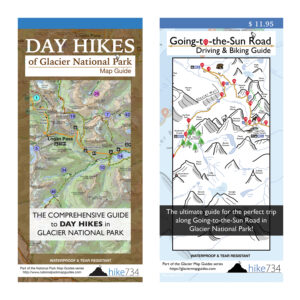Before the road opens to vehicular traffic, biking the Going-to-the-Sun Road is a wonderful experience. This usually occurs around late April/early May until mid or late June. There’s something special about biking the Going-to-the-Sun Road without cars. It gets pretty harrowing once you have to share the road with them.
The road is often gated at either Lake McDonald Lodge or Avalanche Creek on the west side of the Park and Rising Sun or Jackson Glacier Overlook on the east side. From here, you’ll start your ride on your bike. Below are tips and advice to help you plan, prepare, and get the most out of your Going-to-the-Sun Road biking adventure.
Check with the park service for current status
Check with the park service before you head out to learn about the daily closures, regulations, and safety information. Before you head out, check the following pages on the park’s site:
- Glacier National Park Bicycling – This page has regulations, restrictions, and other bike related information.
- Glacier National Park Road Conditions – This page shows you which roads are open to vehicular traffic as well as where the road closures are for cyclists. You can also see which roads are under construction.
Once you arrive in the park, it’s a good idea to ask a ranger at the visitor center for any up to date information. Make sure to read any signs when you get on your bike and obey any closures and signage you may come across along the road.
Info, tips, and safety
Don’t have a bike? Many locations in and around the Park have bikes for rent (conventional bikes, e-bikes, carriers, etc). Check out a list of bike rental places here.
Arrive Early! Parking lots can fill quickly (especially at Avalanche Creek) so get there early in the day! Sometimes the Park runs a free shuttle on weekends, but it isn’t a guarantee so be sure to check the Park website about schedules. You can also book a bike shuttle through multiple companies that also rent bikes (for a guaranteed seat, book with one of them in advance).
Wear appropriate clothing! Pedaling up on a warm day can have you sweating in a t-shirt, but the ride down is a chilly one with the cool mountain air, icy water spray coming off your tires, and weather that can change on a dime. Layering your clothing is crucial to help you navigate these extremes. Always have a hat, gloves, long-sleeve shirt, a rain jacket, and warm jacket with a backpack to put it all in. Bonus tip: Rain pants aren’t a bad idea either.
Bring plenty of food and water. Always bring a bit more food and water than you think you’ll need. There are no grocery stores to swing into if you run out of food.
Bear spray on a bike? You bet! Bring along bear spray as animals frequently use the road for travel too. You can purchase or rent bear spray at many locations in and around the Park. Make sure it’s readily accessible ON YOUR PERSON, not attached to your bike or inside of your backpack. More importantly, stay alert for all kinds of wildlife and give them plenty of space.
Spare and a pump. Have a spare tire and a bike pump with you and know how to fix a flat. Sharp rocks and drainage gates with sharp edges have taken out many a bike tire. You don’t want to walk your bike back.
Know your limits. Your turnaround spot is only halfway, so make sure that you head back with enough energy and food to make it safely.
Know your e-bike’s (range) limits and be conservative. E-bikes are heavier than traditional bikes and become harder to pedal if the battery dies.
E-bike restrictions. Not all e-bikes are allowed. The bike must be under 750 watts and only engaged when pedaling. Throttles are not allowed.
Stay alert and ride on the right side of the road. Good practice is to ride on the right side of the road. This becomes super important as you begin to climb where visibility is decreased and descending cyclists can be going very quickly.
Rock falls and avalanches can happen unexpectedly. Just because an area is open for biking, doesn’t mean that there is a zero chance of rocks falling or even an avalanche. This is especially true in the upper section of the road. Another reason to stay alert, have warm clothing and extra food and water.
The journey is the destination. While pedaling all the way up to Logan Pass is the coveted destination, the entire road may not be open as crews work to clear snow and prepare for vehicular traffic. However, the slower pace of a bike ride in the early season gives you an opportunity to see the Park in a unique and special way. You never know what you’ll see!
Bike Rentals
Numerous shops in the Flathead Valley area rent bikes, carriers, bear spray, and other essentials for your Glacier National Park adventure. Check below for a convenient place for you.
Apgar/West Glacier
Glacier Guides and Montana Raft




